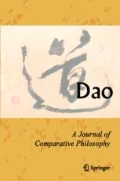Abstract
In this essay, I argue in favor of a novel interpretation of the semantic theory that can be found in the Later Mohist writings. Recent interpretations by Chad Hansen and Chris Fraser cast the Later Mohist theory as a realist theory; this includes attributing to the Later Mohists what we can call “kind-realism,” the idea that there is some correct scheme of kind-terms that carves the world at its joints. While I agree with Hansen and Fraser that the Later Mohist theory is realist in various ways, I offer challenges to their kind-realist interpretations, and argue instead for a kind-conventionalist interpretation on which there is no fixed, correct set of kinds, leaving schemes of kind terms to be determined by conventional decisions that occur during disputation (bian 辯).
Similar content being viewed by others
References
Fraser, Chris. 2005/2015. “Mohist Canons.” Stanford Encyclopedia of Philosophy (Spring 2017 Edition), edited by Edward N. Zalta. https://plato.stanford.edu/entries/mohist-canons/ (last accessed August 8, 2017).
______. 2007. “More Mohist Marginalia: A Reply to Makeham on Canon and Explanation B67.” Journal of Chinese Philosophy and Culture 2: 227–259.
Fung, Yu-lan (Feng Youlan). 1966. A Short History of Chinese Philosophy. 2 vols. Trans. by Derk Bodde. New York: Macmillan Publishing Co.
Graham, A. C. 1978. Later Mohist Logic, Ethics, and Science. Hong Kong: The Chinese University Press.
______. 1989. Disputers of the Dao: Philosophical Argument in Ancient China. Peru, IL: Open Court Publishing Company.
Hansen, Chad. 1983. Language and Logic in Ancient China. Ann Arbor: University of Michigan Press.
______. 1992. A Daoist Theory of Chinese Thought. New York: Oxford University Press.
Ivanhoe, Philip J. 1996. “Was Zhuangzi a Relativist?” In Essays on Skepticism, Relativism, and Ethics in the Zhuangzi, edited by Paul Kjellberg and Philip J. Ivanhoe. New York: SUNY Press.
Mozi 墨子. 1973. In A Concordance to Mozi. Harvard-Yenching Institute Sinological Index Series. Taipei: Chinese Materials Research Aids and Service Center.
Robins, Dan. 2012. “Names, Cranes, and the Later Mohists.” Journal of Chinese Philosophy 39.3: 369–385.
Rorty, Richard. 1989. Contingency, Irony, and Solidarity. New York: Cambridge University Press.
______. 1991. Objectivity, Relativism, and Truth. New York: Cambridge University Press.
Acknowledgments
An earlier version of this essay was written as a part of an M.Phil. thesis with support from the University of Hong Kong. An intermediary version was written with support from Duke University. The current version was written with support of a postdoctoral fellowship from the Center for East Asian and Comparative Philosophy at the City University of Hong Kong. I am grateful to have received a bevy of detailed comments that helped this essay become what it currently is, both from Chad Hansen, Chris Fraser, and David Wong on the original thesis chapter, and from David Wong, Philip J. Ivanhoe, and Alexandra Oprea on subsequent iterations.
Author information
Authors and Affiliations
Corresponding author
Rights and permissions
About this article
Cite this article
Stephens, D.J. Realism and Conventionalism in Later Mohist Semantics. Dao 16, 521–542 (2017). https://doi.org/10.1007/s11712-017-9575-5
Published:
Issue Date:
DOI: https://doi.org/10.1007/s11712-017-9575-5


